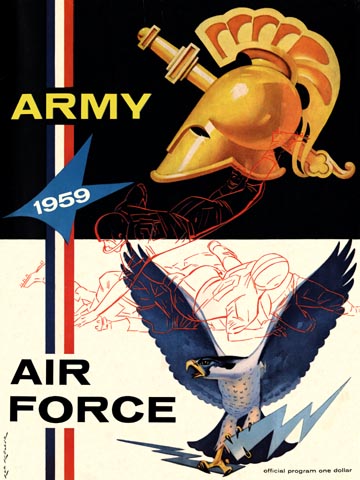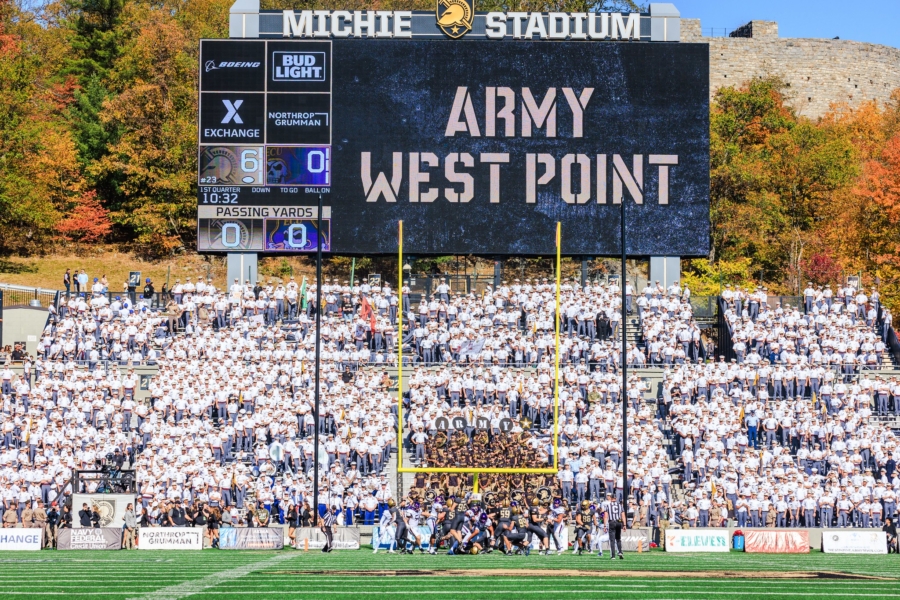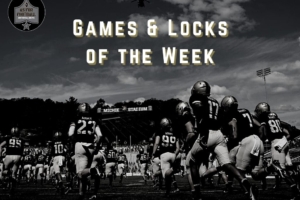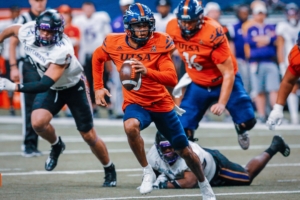TV executives dreamed of the Army-Air Force Game becoming a staple of the college football season when the two academies first clashed back in 1959. And while it may have taken nearly seven decades, the Army-Air Force Game has finally earned its place within the broadcast network TV landscape.

Many college football fans anticipated that first Army-Air Force Game. Academy football remained nationally prominent at that point, and both academies produced legendary seasons in 1958. Army went 8-0-1 and finished #3 in the AP Poll in Red Blaik’s final season. Air Force went 9-0-2 and earned a bid to the Cotton Bowl, where they tied TCU. As a result, NBC picked up the Army-Air Force Game as a regional broadcast as part of the 1959 NCAA broadcast schedule. Back then, before conferences got to negotiate their own TV deals, the NCAA and its television partners released a full schedule of games prior to the season’s start. Though the process eventually evolved to where TV networks could pick games during the season, the NCAA maintained control of the college football television schedule until 1984. Schools even had limits on the amount of times they could appear on TV. The NCAA stipulated that teams could appear only three times every two years and only once yearly on a national broadcast.
This was the landscape for the first four Army-Air Force Games, which took place in 1959, 1963, 1965, and 1969. At that time, service academy football still maintained its traditionally respected place within the national sports landscape, so college football fans nation-wide welcomed another inter-academy clash. Depending on who had the yearly rights to college football games, the “Big Three” networks, ABC, CBS, and NBC, all televised Army-Air Force Games to large regional audiences.
Unfortunately, two turning points decreased the importance of service academy football and thereby limited the exposure of Air Force’s Commander-In-Chief Trophy games.
The first turning point came with the 1969 Texas-Arkansas “Game of the Century.” That showdown, between #1 Texas and #2 Arkansas on December 6, 1969, showed the first hint of the kind of nationwide collegiate brand appeal that we see everywhere today. 52.1% of all American television sets watched Texas and Arkansas play for the de facto national championship that day. This showed that Americans desired important matchups regardless of their specific region of the country. If the academies could not perform as well as the top teams in college football, they would begin to lose their relevance and thus their coveted television status as well.
The second turning point came via the 1973 Army-Navy Game. Though mostly forgotten by both fanbases, the 1973 edition of America’s Game put the television viability of Army-Navy into question. Navy raced out to a 37-0 halftime lead before beating a winless Army team, 51-0. This marked the largest blowout in series history. More importantly, the blowout occured on national television. ABC then left the Army-Navy Game off its preseason national TV schedule the following summer, putting America’s Game in danger of not being nationally televised for the first time since 1947. The network ultimately aired that year’s game nationally, but the ordeal showed the diminished place that service academies had in college football.
For the next 45 years, this was the television landscape. The Army-Navy Game stayed on national over-the-air TV, but there TV executives could find neither the room nor any desire to show Army-Air Force or Navy-Air Force on national networks. Cable networks and syndicators instead aired those games, starting in the 1980s. Army and Air Force only occasionally appeared on network TV from the 1970s through the late 2010s. It took either generational seasons by one of the service academies or significant outside circumstances to put most CiC games on one of the “Big Three” networks.
It took Army’s 8-0 start back in 1996 to convince ABC to come to town for that year’s Army-Air Force game. Still, a merely regional audience watched Army take down Air Force that day, 23-7.
Fifteen years later, another “Game of the Century” impacted Army-Air Force, this time for good. CBS moved the 2011 game between #1 LSU and #2 Alabama to 8:00 PM, leaving its traditional 3:30 pm Eastern afternoon slot open. Army-Air Force took that slot, but the game mustered a mere 1.577 million viewers, CBS’ lowest showing of the season. In 2014, the network experimented with a rare tripleheader, putting Army-Air Force on as an 11:30 am Eastern lead-in for that year’s Florida-Georgia game, which aired ahead of Navy-Notre Dame, playing in primetime for only the second time ever. But again, ratings declined even from their 2011 level, with just 1.66 million viewers tuning in to see Army’s 23-3 loss.
It took resurgent play by both Army and Air Force to remake the game a network TV constant. Army inserted itself back into the national consciousness with three nine-plus win seasons and four bowl bids from 2016-2020. Meanwhile, Air Force returned to national relevance with its ten-win season in 2016 plus its 11-win season in 2019. With the academies now playing better football, more folked want to see them play.
Service academy relevance matters a lot to college football, both from a historic perspective and to die-hard college football fans. CBS executives had this in mind when negotiating the current Mountain West TV deal back in 2020. That agreement called for three games on CBS annually. Air Force home games against the other academies regularly take one of those three slots.
Army’s and Air Force’s returns to network TV show a desire for the heart of college football to shine once again. Last week, Ross Dellenger of Yahoo released an article about Army’s and Navy’s successes without the advantages of NIL. That same day, Heather Dinich of ESPN released a feature on Navy QB Blake Horvath ahead of the Notre Dame-Navy game. Army QB Bryson Daily and Horvath also both appeared recently on the Heisman Trophy podcast, and Daily logged an appearance on The Dan Patrick Show as well.
.@ArmyWP_Football QB Bryson Daily gives us a look at what a typical day in his life at West Point looks like. pic.twitter.com/7x5TZivY0G
— Dan Patrick Show (@dpshow) October 23, 2024
In an age of insatiable greed at all levels of college football, fans want to see selflessness and a team-first attitude take center stage. So while uncertainty may surround the Mountain West’s next television contract after the PAC-12 poached five of its members, Army-Air Force is here to stay on CBS.
It may have taken 65 years, but the Army-Air Force Game has FINALLY found an integral place on network TV.
Go Army! BEAT Air Force!!!
Cover image via USMA Flickr (CDT Connor Faherty).











